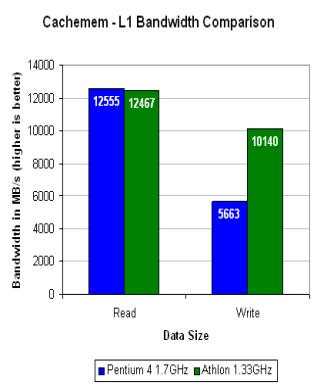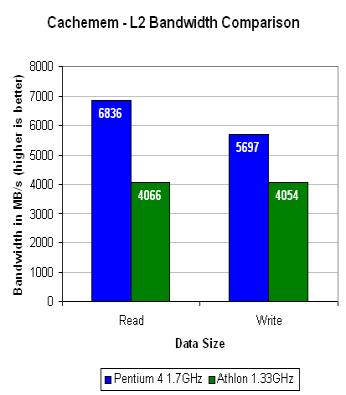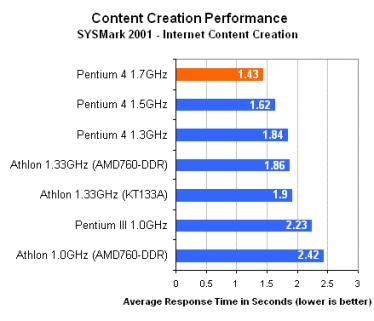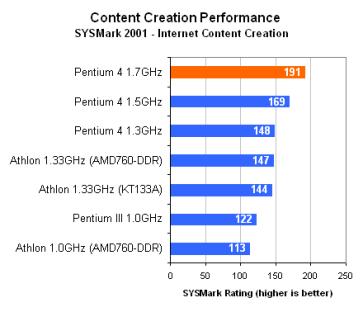 |
 |
||
To better understand the power
and features of the Intel Pentium 4 processor, it is necessary to test it
with
benchmark applications and compare the result with other processors
running on
the same benchmarks. We are going
to focus on the Intel Pentium 4 1.7GHz, and we have selected the following
types
of machine to compare with it. To
see how far Pentium 4 has advanced from Pentium III, we include a
processor from
the Intel family – the 1.0 GHz Pentium III.
The other type of machines are Intel ‘s competitor AMD 1.33GHz
Athlon
”Thunderbird”, and AMD 1.0GHz Athlon “Thunderbird”. All of the machines are installed with the same software,
and
similar hardware to maximum the comparison. The following table and
benchmark
graphs are cited from “AnandTech.com”.
1.
Test with cachmem for latency of the processor.
CacheMem latency comparison
Data size Pentium 4 1.7ghz
Athlon 1.33ghz
4KB
1
1
8KB
2
4
16KB
2
4
32KB
19
4
64KB
19
4
128KB
19
20
256KB
25
20
512KB
281
202
1MB
289
202
2MB
292
229
4MB
292
238
8MB
295
241
16MB
297
244
32MB
297
245
Analysis: From
the table above, we can see that the latency for Pentium 4 is half that of
Athlon 1.33 GHz under 8 KB, this is because Athlon’s 64KB L1 data cache is
much greater than Pentium 4’s 8KB L1 data cache. Therefore, when search
for
data in the L1 cache, Athlon takes longer than Pentium4. However, when the size of the test data grows more than 8KB,
Pentium 4 ‘s latency quickly overcome Athlon’s latency. The reason is that
Pentium 4 run out of L1 cache space and have to relay on its L2 cache for
data
access, thus, increase the latency.
In
contrast, Athlon’s larger L1 data cache allows it to maintain a fairly low
latency up to 64KB. At
the 512KB data point, both of the processors run out of caches and have to
use
their memory to the shortage of cache.
Athlon makes the transition to DDR SDRAM, which gives it an
additional
182-cycle latency. While Pentium 4 is penalized by RDRAM’s higher latency
and
thus suffers an additional 271 cycle memory latency simply when moving to
512KB.
Here is strong evidence showing why a larger L2 cache would
help. In
order to lessen the effects of RDRAM’s relatively high latency, a larger
L2
cache could keep the Pentium 4’s performance quite strong in those
applications that aren’t necessarily memory bandwidth dependent but more
latency dependent.
2. Test with cachmem for bandwidth of caches
 |
 |
||
Analysis: As
you can see from the graph, while reading from the L1 cache is similar in
Pentium 4 and Athlon, writing to the L1 cache is clearly dominate by
Athlon.
Athlon offers almost twice as much bandwidth than Pentium 4 in
writing.
This is because Athlon has 64KB of L1 cache and Pentium 4 has only
8 KB
of L1 cache, as mentioned in the prior test for latency.However,
the result for Athlon’s 64-bit path to its L2 cache is not a pretty
picture.
As the graph shows, Pentium 4 has a huge advantage in L2 cache
bandwidth
of 68% in reads and over 40% in writes in bandwidth intensive applications
–
68 percent more than Athlon in reads and over 40 percent more than Athlon
in
writes. Fortunately, since most of today’s applications are more latency
dependent than bandwidth dependent, AMD’s memory bus can hide this
disadvantage over Pentium 4. This
test shows that overall Pentium 4 wins over Athlon in bandwidth intensive
applications.
3.
Tests with SYSMark 2001 for Content Creation Performance
 |
 |
||
Analysis: from the Synthetic test, we already saw that Pentium 4 wins over Athlon in bandwidth intensive applications because it had greater bandwidth cache access. In this test, since SYSMark 2001 content creation suite is largely based on bandwidth intensive Windows Media Encoder benchmark, not surprisingly, both graph shows that again Pentium 4 wins over Athlon.
Conclusion:
There
are no definite winner between Pentium 4 and Athlon. In some situations, Pentium 4 is better. While in other
cases, Athlon dominates. However,
after the analysis of Pentium 4 and Athlon with different benchmarks, we
do have
the following suggestions.